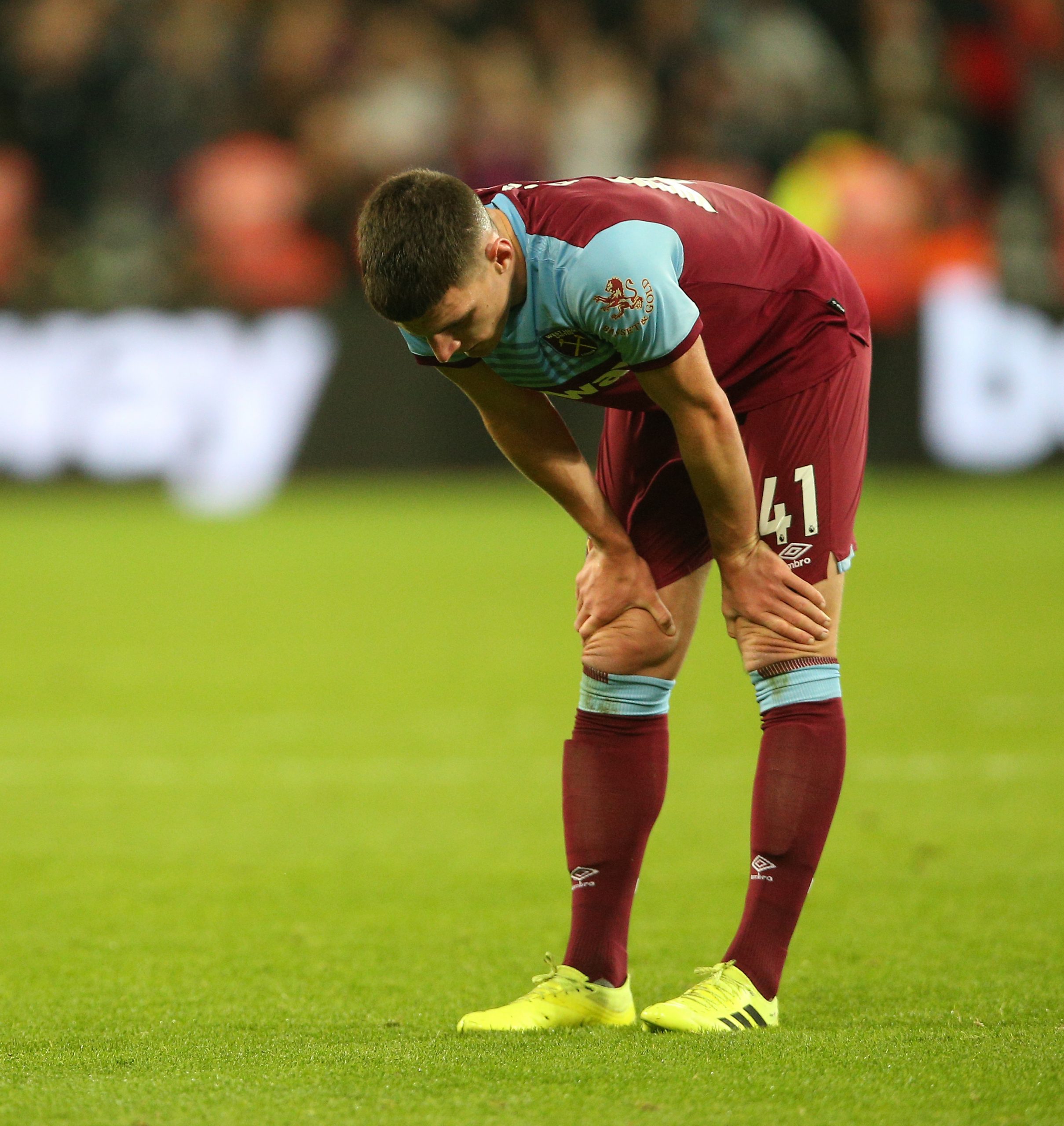Eibar are a club it is hard not to love. A small team from a small city, with a small stadium and a small budget, just the fact that they even reached La Liga was a book-worthy story in of itself. That they’ve stayed there into a sixth season is an incredible achievement. Neither have they merely scraped by in the top flight. After escaping relegation in their first campaign thanks to Elche’s exclusion due to financial issues, Eibar have finished 14th, 10th, 9th and 12th. Last season, they actually had the sixth-best expected goal (xG) difference in La Liga. This underdog narrative has undoubtedly been enriched by the presence of José Luis Mendilibar, a straight-talking maverick of a head coach with an endearingly bold style of play that has made Eibar somewhat of a litmus test for pressing models within the analytics community. If they come out near the top, you know you’re probably on the right track. This tale of overachievement, however, is in danger of coming to an end. Ten matches into the new season, Eibar are not only down in 16th, level on points with Real Betis in 18th, but they also have the second worst xG difference in the division. Only Levante, those serial xG out-performers, currently have a worse differential. Eibar’s xG and xG conceded trendlines have both veered off in the wrong direction. 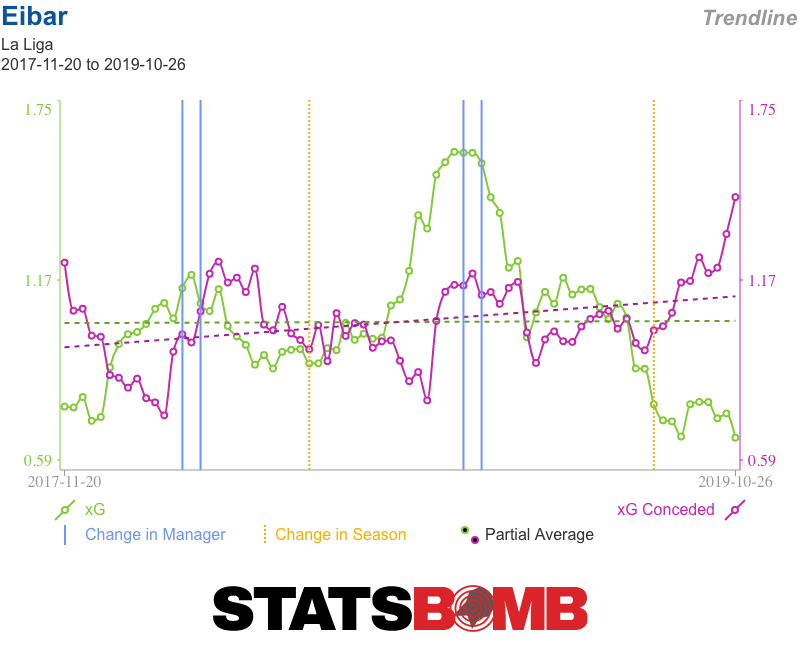 The effect is particularly pronounced in attack, where Eibar’s radar looks downright sad.
The effect is particularly pronounced in attack, where Eibar’s radar looks downright sad.  What xG exists is being propped up by above-league-average performance from set-pieces, but, even then, only barely. Eibar have taken a middling volume of shots of bad average quality. That they’ve even scored 10 goals, twice as many as the league’s three lowest scorers, is due to some mild over-performance of their xG and a pair of penalties. No team in the league is creating less from open play. Their defensive radar doesn’t look quite so bad in an outright sense, but the drop-off in comparison to last season is no less dramatic or concerning.
What xG exists is being propped up by above-league-average performance from set-pieces, but, even then, only barely. Eibar have taken a middling volume of shots of bad average quality. That they’ve even scored 10 goals, twice as many as the league’s three lowest scorers, is due to some mild over-performance of their xG and a pair of penalties. No team in the league is creating less from open play. Their defensive radar doesn’t look quite so bad in an outright sense, but the drop-off in comparison to last season is no less dramatic or concerning.  Eibar are famous for their aggressive high press, but there are signs that its mechanics are unraveling. They are still defending as high as ever, but they are less often and less aggressively seeking to directly break up opposition passing chains. That is not a good combination. If your defensive line stays as high but you begin to defend more passively, it is almost inevitable your opponents will find it easier to pick a way through and create good quality chances. That is exactly what is happening with Eibar. While they are still giving up a very low 8.60 shots per match, the average quality of those shots has increased massively, from 0.12 xG/shot last season to 0.17 xG/shot this time around. They are giving up almost a half a goal worth of xG per match directly from throughballs, nearly double what they did last season.
Eibar are famous for their aggressive high press, but there are signs that its mechanics are unraveling. They are still defending as high as ever, but they are less often and less aggressively seeking to directly break up opposition passing chains. That is not a good combination. If your defensive line stays as high but you begin to defend more passively, it is almost inevitable your opponents will find it easier to pick a way through and create good quality chances. That is exactly what is happening with Eibar. While they are still giving up a very low 8.60 shots per match, the average quality of those shots has increased massively, from 0.12 xG/shot last season to 0.17 xG/shot this time around. They are giving up almost a half a goal worth of xG per match directly from throughballs, nearly double what they did last season.  So what’s up with Eibar? There are personnel issues. Joan Jordán stood out last season as a player capable of performing a variety of midfield tasks. He did his fair share of ball progression, chance creation and defensive work and in doing so earned himself a move to Sevilla. His replacement Edu Expósito produced a delicate lobbed finish to open the scoring in the 2-0 win over Celta Vigo last month but is yet to match Jordán’s overall output on either side of the ball (in fairness, Jordán didn’t start playing his best football until his second season at the club).
So what’s up with Eibar? There are personnel issues. Joan Jordán stood out last season as a player capable of performing a variety of midfield tasks. He did his fair share of ball progression, chance creation and defensive work and in doing so earned himself a move to Sevilla. His replacement Edu Expósito produced a delicate lobbed finish to open the scoring in the 2-0 win over Celta Vigo last month but is yet to match Jordán’s overall output on either side of the ball (in fairness, Jordán didn’t start playing his best football until his second season at the club).  Marc Cucurella also moved on (to Getafe via Barcelona). While he didn’t provide a whole lot of attacking output from the left of midfield, he was a relentless presser, leading the team in pressures and pressure regains last season. Eibar have also had some problems at full-back during the early part of the campaign. The players in those two positions have a key role in Mendilibar’s system in terms of both ball progression and chance creation. Last season, right-back Ruben Peña and left-back Cote led the team in deep progressions and ranked in the top four in terms of key passes (with Peña also at the top of the xG assisted rankings). For the second consecutive season, Eibar saw their starting right-back depart this summer. The year before, Ander Capa had left for Athletic Club; this time, it was Peña who moved on to Villarreal. New signing Álvaro Tejero hasn’t slotted in quite as seamlessly as hoped after a good season in the Segunda División at Albacate, with converted winger Pablo de Blasis preferred on occasion. Add to that the absence through injury of left-back Cote, a decent front-foot defender and varied passer, in four of their 10 matches to date, and it is clear that these two important cogs in Eibar’s system haven’t been functioning as required. More broadly, on a minutes-weighted basis, Eibar had the oldest squad in La Liga last season. Could it simply be that a few of their players are increasingly unable to carry the load of their high-paced approach? Their average age so far this season has increased from 28.8 last time out to 30.0. Their three most-used outfield players (Anaitz Arbilla, Fabián Orellana and Pape Diop) will all be 33 or older by the end of the campaign.
Marc Cucurella also moved on (to Getafe via Barcelona). While he didn’t provide a whole lot of attacking output from the left of midfield, he was a relentless presser, leading the team in pressures and pressure regains last season. Eibar have also had some problems at full-back during the early part of the campaign. The players in those two positions have a key role in Mendilibar’s system in terms of both ball progression and chance creation. Last season, right-back Ruben Peña and left-back Cote led the team in deep progressions and ranked in the top four in terms of key passes (with Peña also at the top of the xG assisted rankings). For the second consecutive season, Eibar saw their starting right-back depart this summer. The year before, Ander Capa had left for Athletic Club; this time, it was Peña who moved on to Villarreal. New signing Álvaro Tejero hasn’t slotted in quite as seamlessly as hoped after a good season in the Segunda División at Albacate, with converted winger Pablo de Blasis preferred on occasion. Add to that the absence through injury of left-back Cote, a decent front-foot defender and varied passer, in four of their 10 matches to date, and it is clear that these two important cogs in Eibar’s system haven’t been functioning as required. More broadly, on a minutes-weighted basis, Eibar had the oldest squad in La Liga last season. Could it simply be that a few of their players are increasingly unable to carry the load of their high-paced approach? Their average age so far this season has increased from 28.8 last time out to 30.0. Their three most-used outfield players (Anaitz Arbilla, Fabián Orellana and Pape Diop) will all be 33 or older by the end of the campaign.  Could a combination of that and the intensity of Mendilibar’s style of play finally have worn down on the squad? He himself spoke earlier this season of the need for the team to rediscover their essence. “We are not putting together the sort of football that characterised us in recent years,” he said. “I am not a friend of statistics but it is true that in the last few seasons we have been the team who have won the ball most often in the opposition half, who have put in the most crosses, and many other things. In the start to this season, without looking at the data, we haven’t felt like ourselves in terms of those parameters.” Mendilibar has experimented with a switch to a 4-3-3 formation a couple of times in recent matches in an attempt to reverse the downward trend, but to limited effect. “We have to think about what can be done, and what it is that we aren’t doing well right now,” he said after their 2-0 defeat away to Real Valladolid at the weekend. Solutions will have to be found fast if Eibar are to avoid a season-long relegation scrap.
Could a combination of that and the intensity of Mendilibar’s style of play finally have worn down on the squad? He himself spoke earlier this season of the need for the team to rediscover their essence. “We are not putting together the sort of football that characterised us in recent years,” he said. “I am not a friend of statistics but it is true that in the last few seasons we have been the team who have won the ball most often in the opposition half, who have put in the most crosses, and many other things. In the start to this season, without looking at the data, we haven’t felt like ourselves in terms of those parameters.” Mendilibar has experimented with a switch to a 4-3-3 formation a couple of times in recent matches in an attempt to reverse the downward trend, but to limited effect. “We have to think about what can be done, and what it is that we aren’t doing well right now,” he said after their 2-0 defeat away to Real Valladolid at the weekend. Solutions will have to be found fast if Eibar are to avoid a season-long relegation scrap.
Stats of Interest
To illustrate what I mentioned earlier about Levante’s perennial outperformance of xG, just take a look at this chart from the start of the 2017-18 season to now. All the green area is outperformance. Paco López and his team are clearly doing something a bit different.  Getafe seem to have taken on Eibar’s mantle as La Liga’s most extreme high-pressing team. They have defended further from their own goal than any other team so far this season, and have also allowed fewer passes per defensive action than anyone else.
Getafe seem to have taken on Eibar’s mantle as La Liga’s most extreme high-pressing team. They have defended further from their own goal than any other team so far this season, and have also allowed fewer passes per defensive action than anyone else.  Barcelona weren’t in action at the weekend, but it’s worth noting a little quirk about goalkeeper Marc-André Ter Stegen. Last season, he took 6% of his goal kicks with his weaker left foot; this time around that has more than doubled to 13.70%. We are still working with a limited sample size, and part of that can be attributed to the new goal kick law, as five of his 10 left-footed deliveries have been played within the confines of the penalty area. But he has also produced a couple of accurate longer deliveries.
Barcelona weren’t in action at the weekend, but it’s worth noting a little quirk about goalkeeper Marc-André Ter Stegen. Last season, he took 6% of his goal kicks with his weaker left foot; this time around that has more than doubled to 13.70%. We are still working with a limited sample size, and part of that can be attributed to the new goal kick law, as five of his 10 left-footed deliveries have been played within the confines of the penalty area. But he has also produced a couple of accurate longer deliveries. 





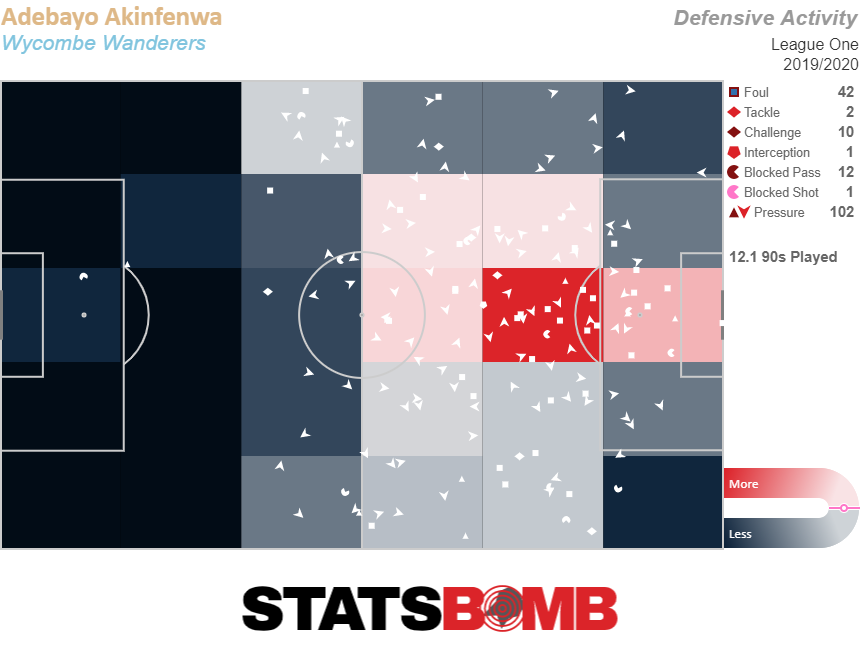






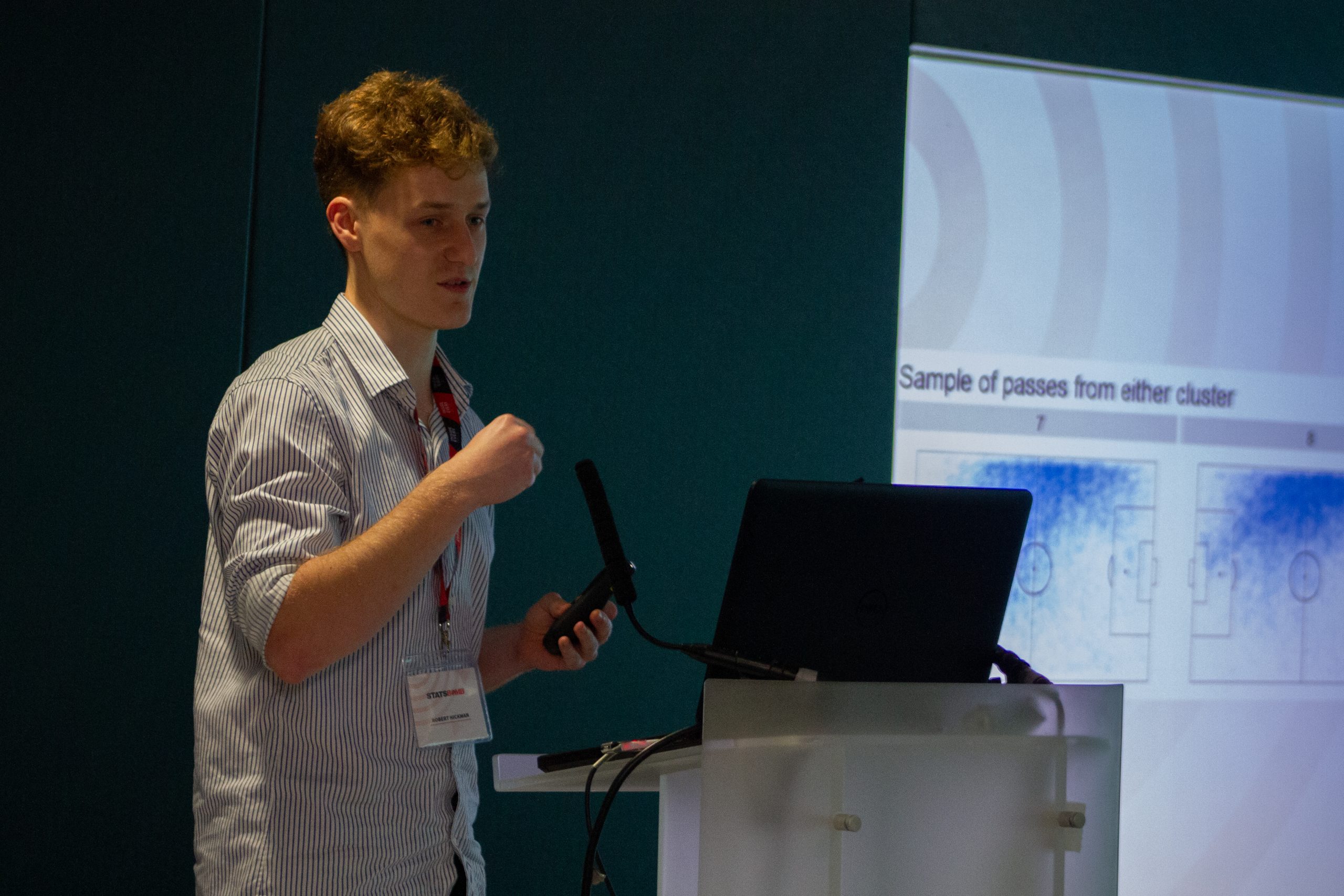


 The side primarily uses the up-back-and-through strategy, which sees a forward player receive with their back to goal, only to lay it off to the goal-facing player deep of them, who will then launch it further forwards to a runner beyond the initial receiver. In their games against Union and Lyon, in particular, Leipzig attempted to do this by having the centre backs play it into Marcel Sabitzer’s feet, where the near-sided holding midfielder would – and in the case of the Union game, shift his position wider to be in line with the Austrian – receive goal-facing before they could then feed Lukas Klostermann’s runs beyond them.
The side primarily uses the up-back-and-through strategy, which sees a forward player receive with their back to goal, only to lay it off to the goal-facing player deep of them, who will then launch it further forwards to a runner beyond the initial receiver. In their games against Union and Lyon, in particular, Leipzig attempted to do this by having the centre backs play it into Marcel Sabitzer’s feet, where the near-sided holding midfielder would – and in the case of the Union game, shift his position wider to be in line with the Austrian – receive goal-facing before they could then feed Lukas Klostermann’s runs beyond them.  Where Leipzig have struggled altogether in buildup has been in the two aforementioned games, against Frankfurt and Werder Bremen, where they fielded 3-5-1-1 setups in attack. The offensive shape is often a consequence of how Nagelsmann wishes to defend against opponents, which is, particularly at this early stage, potentially limiting given how unfamiliar the attackers are playing in certain systems. In the former, the main tactic was to have the near-sided wide forward move out to the wing to receive free of pressure, but when they did, they had no option to play into next. Here, Sabitzer drops wide, free of any marker, but has no options once he receives the ball there.
Where Leipzig have struggled altogether in buildup has been in the two aforementioned games, against Frankfurt and Werder Bremen, where they fielded 3-5-1-1 setups in attack. The offensive shape is often a consequence of how Nagelsmann wishes to defend against opponents, which is, particularly at this early stage, potentially limiting given how unfamiliar the attackers are playing in certain systems. In the former, the main tactic was to have the near-sided wide forward move out to the wing to receive free of pressure, but when they did, they had no option to play into next. Here, Sabitzer drops wide, free of any marker, but has no options once he receives the ball there. 
 Typically, you’ll see Werner occupy positions either wide of or inside the near-sided fullback since these aerial balls are directed towards either halfspace, with his position pinning open space for Poulsen to challenge in. Deep of Werner are Sabitzer and/or Forsberg either side of the Dane, with the holding midfielder(s) pushed up to form a diamond around him, meaning that any balls coming back can be played forward into runners first-time.
Typically, you’ll see Werner occupy positions either wide of or inside the near-sided fullback since these aerial balls are directed towards either halfspace, with his position pinning open space for Poulsen to challenge in. Deep of Werner are Sabitzer and/or Forsberg either side of the Dane, with the holding midfielder(s) pushed up to form a diamond around him, meaning that any balls coming back can be played forward into runners first-time.  Clearly, though, their best chances, as you’d expect, come through quick transitions. The main way in which they’ve looked to escape pressure and set off attacks is based around the same up-back-and-through strategy they used in settled possession. This frequently involves Poulsen being readily available to receive the ball just ahead of the midfield line, where he can then lay it off to the various runners joining the attack, or simply back to the teammate who played it his way, as they will undoubtedly have more space to operate in after the exchange. Then, further ahead, you have Werner, particularly down the left side, moving as wide as possible to be both a short option and to be an attacker who can run from out-to-in.
Clearly, though, their best chances, as you’d expect, come through quick transitions. The main way in which they’ve looked to escape pressure and set off attacks is based around the same up-back-and-through strategy they used in settled possession. This frequently involves Poulsen being readily available to receive the ball just ahead of the midfield line, where he can then lay it off to the various runners joining the attack, or simply back to the teammate who played it his way, as they will undoubtedly have more space to operate in after the exchange. Then, further ahead, you have Werner, particularly down the left side, moving as wide as possible to be both a short option and to be an attacker who can run from out-to-in.  However, when you’re looking ahead and debating whether the current profiles can do enough to last the whole season, the one qualm might be the depth offered by Matheus Cunha, who pales in comparison to the balance Poulsen offer, but, statistically at least, you have four central attackers who are so experienced with this club and all have outstanding output so far, both in terms of creating and getting on the end of chances. When looking ahead, the sky really is the limit for this side, especially under the most talented young coach in the World, whose ceiling is yet to be established. ~ Stay tuned for part two, which will look at Leipzig’s pressing and defending.
However, when you’re looking ahead and debating whether the current profiles can do enough to last the whole season, the one qualm might be the depth offered by Matheus Cunha, who pales in comparison to the balance Poulsen offer, but, statistically at least, you have four central attackers who are so experienced with this club and all have outstanding output so far, both in terms of creating and getting on the end of chances. When looking ahead, the sky really is the limit for this side, especially under the most talented young coach in the World, whose ceiling is yet to be established. ~ Stay tuned for part two, which will look at Leipzig’s pressing and defending.


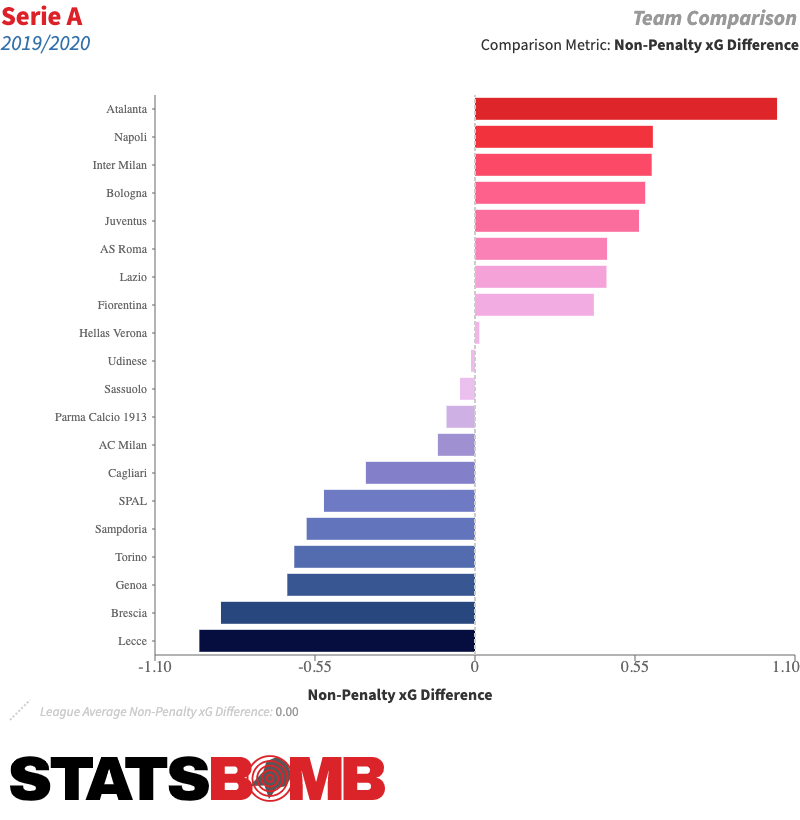














 Another member of the Barcelona midfield has also looked good. Last season, Arthur settled in well following his move from Gremio in Brazil. This time around, he has been set the target of increasing his attacking output by coach Ernesto Valverde. He has responded gamely, scoring his first goals for the club, doubling his through-ball and shot output, increasing his key pass and expected assist numbers, and taking a huge jump forward in terms of successful dribbles.
Another member of the Barcelona midfield has also looked good. Last season, Arthur settled in well following his move from Gremio in Brazil. This time around, he has been set the target of increasing his attacking output by coach Ernesto Valverde. He has responded gamely, scoring his first goals for the club, doubling his through-ball and shot output, increasing his key pass and expected assist numbers, and taking a huge jump forward in terms of successful dribbles.  Not since Andrés Iniesta in 2013/14 (thanks
Not since Andrés Iniesta in 2013/14 (thanks  Last season, only 12 players in the big five leagues recorded 0.50 or more xG per 90. Most of those were high volume shooters, with only two of them taking less than three shots per 90. Loren is averaging just over two so far, which does place a question mark over the sustainability of his output. In that group, Edinson Cavani has the most similar shot profile, but he plays for a dominant team in his league. Loren has shown himself to be a sharp and decisive presence inside the area, but he is relatively service reliant.
Last season, only 12 players in the big five leagues recorded 0.50 or more xG per 90. Most of those were high volume shooters, with only two of them taking less than three shots per 90. Loren is averaging just over two so far, which does place a question mark over the sustainability of his output. In that group, Edinson Cavani has the most similar shot profile, but he plays for a dominant team in his league. Loren has shown himself to be a sharp and decisive presence inside the area, but he is relatively service reliant.  It is also worth noting that at this stage last season, Loren sat on 0.48 xG per 90. Of the five players in the league who were averaging over 0.50 xG per 90 at that juncture, only one of them maintained it over the course of the entire campaign (although Levante’s Roger Martí came very close, at 0.49 xG per 90). Loren ended up with a seasonal average of 0.34 per 90, a smidgen up from his mark during his first half-season in the first team. Can he sustain his improved top-line and underlying numbers this time around?
It is also worth noting that at this stage last season, Loren sat on 0.48 xG per 90. Of the five players in the league who were averaging over 0.50 xG per 90 at that juncture, only one of them maintained it over the course of the entire campaign (although Levante’s Roger Martí came very close, at 0.49 xG per 90). Loren ended up with a seasonal average of 0.34 per 90, a smidgen up from his mark during his first half-season in the first team. Can he sustain his improved top-line and underlying numbers this time around?  Defensively, he looks better on the front foot and does struggle a bit with movement in and around him in more set situations. But that is something that can be refined over time. As it is, in Reguilón and Achraf Hakimi (on loan at Borussia Dortmund), Real Madrid have two young and talented full-backs capable of competing in the first team group next season if space opens up for them to do so.
Defensively, he looks better on the front foot and does struggle a bit with movement in and around him in more set situations. But that is something that can be refined over time. As it is, in Reguilón and Achraf Hakimi (on loan at Borussia Dortmund), Real Madrid have two young and talented full-backs capable of competing in the first team group next season if space opens up for them to do so. 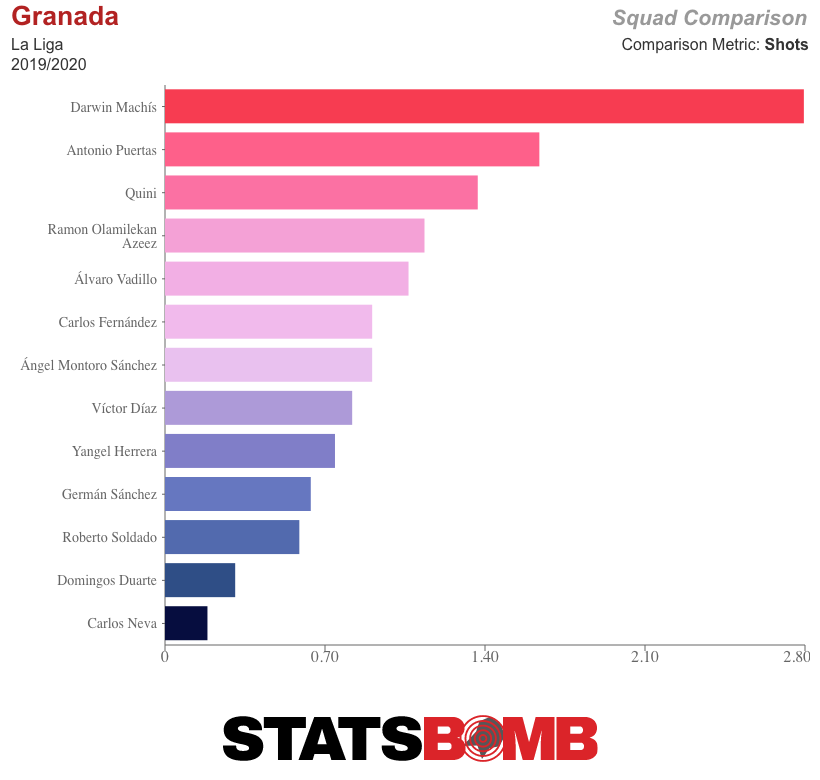 A league-third-high (amongst players with at least 400 minutes) 4.53% of his total touches to date have been shots. They’ve not exactly been a stellar selection of efforts:
A league-third-high (amongst players with at least 400 minutes) 4.53% of his total touches to date have been shots. They’ve not exactly been a stellar selection of efforts:  But within the context of a team who don't necessarily have the personnel to consistently create good looks in open play, a player capable of advancing upfield and getting off shots can still form a useful part of a wider and more varied game plan.
But within the context of a team who don't necessarily have the personnel to consistently create good looks in open play, a player capable of advancing upfield and getting off shots can still form a useful part of a wider and more varied game plan. 